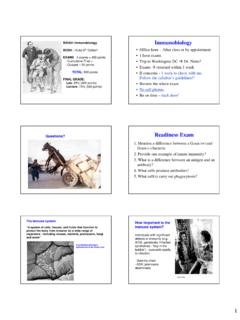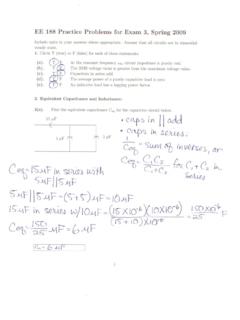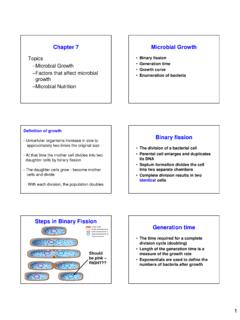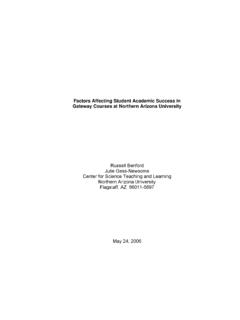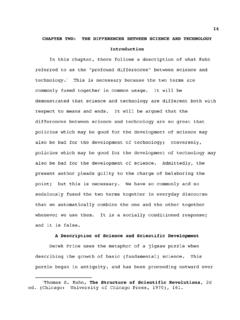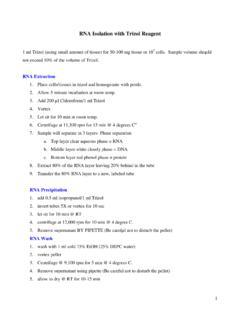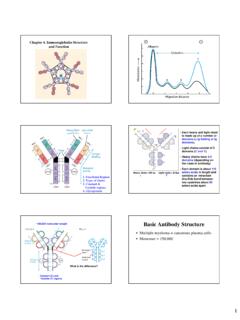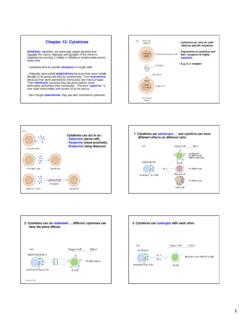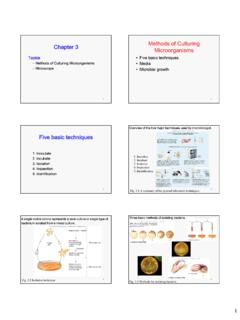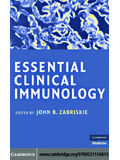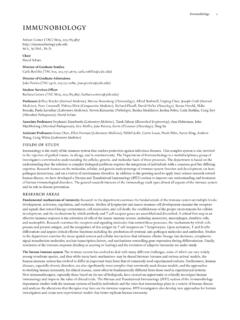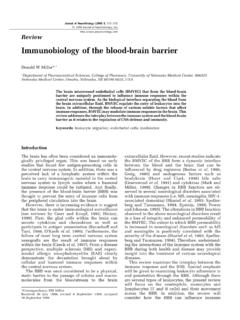Transcription of BIO 401. IMMUNOBIOLOGY. FALL 2012 REVIEW SHEET FOR FIRST ...
1 BIO 401. immunobiology . fall 2012 . REVIEW SHEET FOR FIRST EXAM (This is only an study aid to help you prepare for the exam!!!) CHAPTER 1. Overview of the immune system. 1. Be familiar with different scientists and their contributions to the field of immunology (only those covered in class): small pox, Pasteur, Lady Montagu, Jenner, etc. 2. Be familiar with the historical contributions that allowed the discovery of humoral and cellular immunities. Be familiar with the term toxin, toxoid, etc. 3. Be able to differentiate between innate and acquired immunity. 4. Be able to differentiate between variolation and vaccination; attenuated vaccines. 5. Be familiar with examples from anatomical barriers. 6. Be familiar with examples from physiological barriers. 7. Be able to explain or elaborate on the mechanisms of action of the following nonspecific defense mechanisms: unbroken skin, mucous membranes, one way flow of fluid, localized chemical environment ( on the skin or in the stomach), peristaltic action of the intestine, desquamation of epithelial cells on mucosal linings, self cleaning properties of mucous membranes, nasal hair, and normal flora (note that this single question covers a large amount of material).
2 Are any of these defense mechanisms inducible or are they entirely constitutive? 8. The phagocytic system is said to be our second line of defense against pathogens. Be familiar with the different steps in the process of phagocytosis. Be familiar with the different types of macrophages (fixed or wandering). What are the two functions of phagocytosis? 9. Describe the inflammatory response. 10. Describe in conceptual terms the protective effects of the inflammatory response. What is/are the outcome? 11. Be familiar with the characteristics of acquired or specific immunity. What are the two phases of the Immune response? 12. In general terms, what is the role of B and T lymphocytes in the humoral immune response? What is a plasma cell? Why do we need the intervention of CD4 T helper cells in an antibody response (what happens when T helper cells are not involved in an antibody response?)? 13. What is the role MHC in T cell activation?
3 Be familiar with MHC molecules. 14. What is an APC? Why they are important during acquired immunity? What are the requirements to be an APC? What cells do MHC interact with? 15. Be prepared to describe the process by which an antibody immune response is initiated up through the production of plasma cells releasing antibody. What are the functions of the antibodies produced in response to infection? 16. How are antigens/epitopes recognized by B or T cells? 17. What are the cell membrane molecules involved in antigen recognition by T and B cells? 18. Make sure you understand what is the MHC complex? What role it plays during antigen presentation? What the term restriction means? 19. Be able to explain the clonal selection theory in the context of generating an immune response. 20. What is the role of MHC-I and MHC-II in antigen recognition by T cells? What cells they interact with? What antigens they interact with? etc.
4 21. Explain the differences between the "primary" and the "secondary" (or anamnestic) immune responses. What aspects of the secondary immune response are particularly important when we give booster shots of a vaccine? Why we believe that when we can mount a secondary immune response to a pathogen,.. we are immune to that pathogen!!!! CHAPTER 2. Cells of the immune system 1. Be able to describe the origin of the leukocytes, lymphocytes, and RBCs found in the blood. What are the lineages? Why do we need hematopoiesis? 2. What is the HSC? What progenitors are produced from these cells? What are stromal cells? What is the role of stromal cells during T and B cell development? 3. Describe apoptosis, be familiar with at least 1 gene promoting or preventing apoptosis, and the difference between apoptosis and necrosis. Why is apoptosis important in hematopoiesis? 4. Be able to differentiate between plasma and serum. 5.
5 Among the lymphoid cells, be able to describe unique surface markers (CD molecules) for B, T and NK cells. Be familiar with at least 3 of them. 6. Be familiar with at least ONE function of the 3 cells described above. 7. Be able to provide example of fixed and wandering macrophages. 8. Provide the function(s) of macrophages. 9. Be able to identify granulocytes and provide their main biological function. 10. How are basophils different from mast cells? 11. Be able to provide the role of dendritic cells and know at least two of them. 12. Be able to provide the main differences between primary and secondary lymphoid organs. 13. Be able to identify the location of immune cells in the spleen and lymph nodes. 14. What is the main role played by the spleen? 15. Provide one example of a MALT. What type of cell is involved in antigen uptake in the intestines? Why are follicles in the Peyer s patches always activated? What antibody is produced in mucosal sites?
6 Where would you expect antigen captured by DC to move to start an immune response? 16. Know about the lymphatic system. Why is it important? How the lymph and lymph nodes come together? 17. Be familiar with role played by HEV in secondary lymphoid tissues. 18. Explain what happens when the immune system goes dysfunctional. What happens in AIDS or DiGeorge syndrome? CHAPTER 3. Innate Immunity. 1. Once again be familiar with innate immune defenses and how they protect us from infection. 2. Be familiar with at least two-three differences between innate and specific immunity. 3. In connecting innate and specific immunity, be familiar with the role played by MBL, CRP, and complement proteins during infection (Fig 3-4). 4. Be familiar with the inflammatory response. 5. Provide at least 5 steps on how blood cells are recruited to sites of tissue injury? (Fig 3-7) 6. Among the anti-microbial peptides be familiar with the mode of action of defensins and interferons.
7 7. In the acute phase response, be familiar with C-reactive proteins and mannose-binding lectin. How these proteins contribute to immunity? (similar to question 3). 8. Be familiar with NOD receptors and Toll-like receptors. The Toll-like receptors is a big area of research and it makes for lots of exam questions. 9. Be familiar with the Toll-like receptors family, their structure (homo- vs hetero-dimers), localization, and most of all their target antigens. 10. How neutrophils control pathogens? What roles do phox, reactive oxygen species, and reactive nitrogen species play during the process of phagocytosis? What are oxygen-independent (or non-oxidative) mechanisms? 11. How is nitric oxide generated during phagocytosis? What happens when nitric oxide is not produced during infection? 12. Macrophages are good eating cells but they become angry/mean cells when activated. Provide at least 3 changes in these cells following activation.
8 13. Be familiar with the contribution by NK cells during acute infection. 14. What is the role of dendritic cells in linking innate and adaptive immunity? 15. TLR signaling. Be familiar with the adaptors proteins that start each of the pathways, the transcription factors involved, and the end products of activation. CHAPTER 4. Antigens. 1. What are the definitions for: antigens, epitopes, immunogens and antibodies. 2. What are the differences between immunogenicity and antigenicity? How can you explain that haptens in order to induce an immune response need to be conjugated to a carrier protein? 3. Be prepared to explain for example, why one would expect that the humoral immune response to the GP120 HIV virus receptor would be expected to elicit antibodies with many different recognitions (for different antigenic determinants). In this respect, know what is meant by a polyclonal antibody response. 4. Why antigens need to be greater than 5,000 Daltons in order to efficiently stimulate an immune response.
9 Think about why that might be so. Overall, you need to know the properties that contribute to the immunogenicity of an antigen. 5. What are adjuvants? What are the most commonly used adjuvants? How do they work? 6. For what sorts of antigens do we mount the strongest and the weakest immune responses? 7. You need to be familiar with how antigens are seen by T and B cells? 8. What do we mean by sequential or conformational epitopes?
